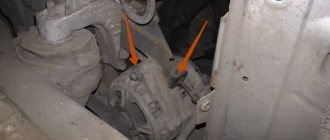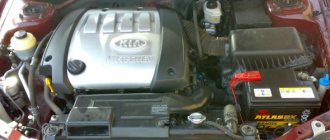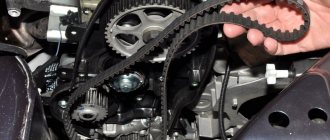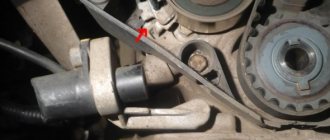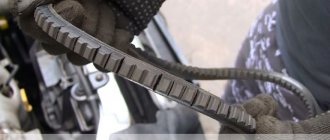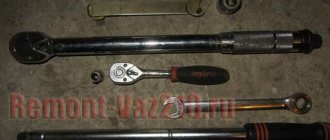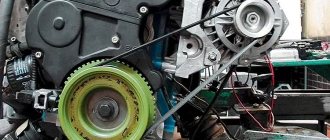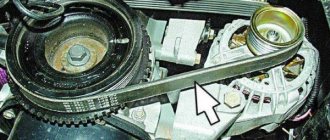The timing belt synchronizes engine operation. Without it, the car simply won’t start, and if it was working and the belt breaks or falls off, the engine will instantly stall. And if the engine bends the valves, it will not only stall, but also bend the valves. True, this does not apply to 8-valve cars of the Samara-2 family. The belt must be changed on time, its condition monitored and maintenance carried out. Belt rupture, flying off and other troubles depend on the quality of the belt and the pump. We recommend that you always carry a new belt with you in the trunk, because replacement is a simple and short process. This prospect is much more pleasant than a breakdown far from home, garage or service station. Here only a tug or tow truck will save you.
Note! You will need the following tools: spanners, a 10mm socket wrench, a mounting spade (sold at a reasonable price at a car dealer, but a thick, strong screwdriver will do instead), a special wrench for turning the tension roller (two thin drills and a screwdriver will do instead) , knob with cap heads.
Timing belt location
The belt is hidden under a cover from dirt and other debris. This cover is made of plastic and can be easily removed by unscrewing the fastening bolts. Having removed the cover, the entire timing mechanism will appear before your eyes (except for the pistons, their connecting rods, valves, etc., they are located in the cylinder block). Below we have posted a photo where the belt is clearly visible (indicated by a red arrow), and we indicated the camshaft pulley with a blue arrow, the pump with a green arrow, and the tension roller (which regulates the tension of the belt) with a yellow arrow. Remember the details listed.
When is it necessary to change the belt?
It is advisable to look at it every 15-20 thousand kilometers. Visual signs of wear are obvious: you will find traces of oil, signs of wear on the toothed surface of the belt (puts on the pulleys and holds the belt), various kinds of cracks, folds, peeling of rubber and other defects. The manufacturer recommends replacing it every 60,000 thousand km, but we do not recommend such long intervals.
Replacing the timing belt on a VAZ 2113-VAZ 2115
Removal
1) First, remove the plastic cover that covers the belt from dirt, various types of water and lubricants. The cover is removed as follows: take a wrench or socket wrench and unscrew the three bolts securing the cover (in the bottom photo the bolts are already unscrewed). Two bolts are present on the side and hold the cover in place, and one is located in the central part. By unscrewing them, you can remove the cover from the car engine.
2) Now turn off the power to the car by disconnecting the negative terminal from the battery. Then remove the alternator belt - read the article for details: “Replacing the alternator belt on a VAZ.” Set the piston of the fourth and first cylinders to TDC (top dead center). Simply put, place both pistons completely straight and without angles up.
3) Then take a “13” wrench in your hands and use it to slightly loosen the nut securing the tension roller. Loosen until the roller begins to rotate. Then turn the roller by hand so that the belt loosens. Grasp the belt and carefully remove it from the rollers and pulleys. You need to start from the top, with the camshaft pulley. It will not be possible to remove all the pulleys, so only release the belt at the top.
4) Next, remove the front right wheel (removal instructions are available here: “Correct replacement of wheels on modern cars”). Now take a socket wrench or any other wrench that can unscrew the bolt securing the generator drive pulley (the pulley is indicated by the red arrow).
Note! The bolt is unscrewed with the help of a second person (assistant) and a mounting spatula (or a thick screwdriver with a straight blade). From the left side (in the direction of travel of the car) of the clutch housing, remove the plug marked in red. Then a spatula or screwdriver is inserted between the teeth of the flywheel (the teeth are indicated in blue) - the flywheel is kept from turning. You will have to use force, the main thing is not to overdo it. After unscrewing the bolt, remove the pulley and set it aside!
5) Now you will have excellent access to the crankshaft pulley and belt. At the last moment, the belt is removed from the lower pulley. It has now been completely removed.
Note! Although this does not apply to 8-valve cars of the Samara family, for general information we will explain: do not have the habit of turning the camshaft and crankshaft pulleys when the belt is not installed. Otherwise, you will mess up the valve timing (they are easy to adjust; you just need to align the flywheel and pulley to the marks). Turning the pulley, for example, on a 16-valve Priora, will cause the valve to meet the piston group and they may be slightly bent.
Installation
1. Carry out in the reverse order of removal, observing some nuances:
- firstly, we recommend that you clean the pulleys and tension roller from dirt and various types of grease that get on them over time;
- After cleaning, degrease the pulleys and tension roller using white spirit;
- start installation.
Install the belt first on the pulley from the bottom, moving to the top. As you put it on, it will sag, so pull it with your hands and make sure that it stands up straight and the pulleys are not distorted. After installation, make sure the marks match, then proceed to install the tension roller. Install the belt onto the tension roller (see photo 1), then climb down and reinstall the generator drive pulley. Be sure to ensure that the hole on the pulley, indicated by letter A, lines up with the mounting sleeve, indicated by letter B in the second photo. If you have a torque wrench (a very convenient thing that allows you to tighten bolts and nuts to a certain torque without overtightening them), tighten the bolt securing the generator drive pulley. The tightening torque is 99–110 N m (9.9–11.0 kgf m).
Next, proceed to adjusting the timing belt on the car: insert two drills or self-tapping screws into the two holes present on the tension roller (the holes are indicated by arrows in photo 1). In a good way, the adjustment is made with a special key. however, not everyone has one, so we are looking at an alternative method of tensioning. Insert two screws and insert a screwdriver between them (photo 3), then turn the roller counterclockwise. With the belt fully tensioned, tighten the nut securing the roller fully and fully (photo 3). Make sure that the steps have been carried out correctly: by hand, turn the belt exactly in the middle part between the pulleys with a force of 1.5-2 kg. If it turns approximately 90° (photo 4), then the belt is adjusted correctly. Otherwise, repeat the adjustment.
Note! An overtightened belt will lead to failure of the roller, belt and pump. A weak, under-tightened belt, while driving at high speeds, will jump off the pulley teeth and the adjustment of the gas distribution phases will be disrupted - the engine will not work properly.
2. Having installed the parts in place, be sure to check the alignment of the marks and check the belt tension.
Install a new belt and tension it
Work order
1. We put on the belt, starting with the crankshaft gear.
2.Having passed the belt through the fluid pump gear and tension roller, we put it on the timing shaft gear.
3. To tension the belt, a special key is usually used to rotate the tension roller. If you do not have such a tool, you can use ordinary self-tapping screws, screws or bolts. We insert them into the holes in the roller body (2 pieces), and by passing a screwdriver between them, rotate the roller counterclockwise, tensioning the belt. Periodically check the belt tension.
4. The belt tension, without using a special tool called a strain gauge tester, can be checked by rotating it around its vertical axis. To do this, grasp its surface with two fingers (thumb and forefinger) at the point between the timing camshaft sprocket and the fluid pump gear, and rotate the belt around its vertical axis. If its plane rotates more than 90 degrees, tighten it further. The tension can be considered optimal when the belt rotates 80-90 degrees. But do not overdo it: too much tension will wear out both the belt and the pump bearing.
5.If the timing belt tension is normal, tighten the nut securing the tensioner pulley (13 wrench). We pull out the screws (screws, bolts) from the roller body.
6. Throwing a 19mm wrench onto the crankshaft pulley mounting bolt, turn the shaft 2 turns. Check to see if the marks have gone astray. If everything is normal, we continue installation. If the marks are lost, you will have to remove the belt and repeat everything again.
7. On the crankshaft, unscrew the generator drive pulley bolt again (19mm wrench). Install the previously removed pulley onto the crankshaft. Fix the flywheel with a screwdriver and tighten the bolt.
8. We put on the generator belt and tension it.
9. We check the results of the work done. We start the engine and listen to its operation. If the engine runs normally, then you have done everything correctly.
10.Put the protective cover of the timing drive in place, tighten the 3 bolts securing it (10mm wrench).
11. Bend the engine protection and use the same wrench to tighten the 2 bolts securing it to the body.
12.Mount the right front wheel.
13. We lower the car, do not forget to securely tighten the bolts securing it.
This, in principle, is the entire algorithm for replacing the timing belt. As you can see, it is not as complicated as it might seem at first glance. Of course, it is impossible to foresee all the nuances that may arise during the replacement process, but the information provided should be sufficient to cope with this task. Moreover, in the event of an error, the engine will not be damaged in any way.
If you still have questions or need more detailed information, watch a video about how the process of replacing the timing belt on a VAZ 2115 car takes place
A broken timing belt while on the road can cause a lot of inconvenience. On a VAZ-2115, this breakdown can lead to bending of the valves, which can lead to more expensive repairs. An unpleasant situation can also arise if a breakdown occurs on the road. Below we will look at the causes of this malfunction and provide instructions for eliminating it.
Timing belt on VAZ 2115: do-it-yourself replacement
The design of the gas distribution mechanism on the VAZ 2115 car is identical to the previous modifications 2114, 2112, 2110. The main purpose of the timing gear is to transmit torque from the crankshaft to the camshafts for the subsequent movement of the car.
During the systematic operation of a technical device, the drive often fails. At high speeds and rpm, the belt breaks into pieces, blocking the operation of the cylinder head and valve mechanism. There are frequent cases of holes in the block and valve bends.
The process of replacing the drive yourself is not at all complicated, but it requires attentiveness on the part of the technician. Violation of technology is not acceptable. If you encounter any difficulties with repairs, contact a service station specialist for help.
On VAZ 2115 cars a toothed belt is pre-installed. Unlike wedge and poly-wedge, it has a long service life. The cost of the belt is 10% higher than analogues.
Early models of VAZs were equipped with chain drives, but they are not as efficient and have a higher noise level during operation.
Diagnostics
Diagnostics must be carried out every 20,000 km of the vehicle. To do this, remove the protective cover and inspect the belt. The belt should not have chips, tears or cracks. Also, it should not have unraveling threads, etc. After inspecting the belt, it is necessary to inspect the rollers and listen to them with the engine running for noise.
Old cracked timing belt
It is necessary to inspect the alignment of the belt relative to the camshaft pulley, crankshaft, pump and rollers.
Timing belt on a VAZ 2115 car
The belt drive on the VAZ 2115 is identical in size to the VAZ 2110 - 2114. Technical characteristics of the drive: length 1306 x number of teeth 116 x width 9.5 mm.
| Name/article | Price in rubles |
| Original | |
| VAZ-2112 / 2110 engine 16 valves, 2112-1006040-83 | From 1600 |
| VAZ 21120 (2110)-1006040-00 | From 1600 |
| VAZ 2112 (2110)-1006040 (16 valves) | From 1600 |
| GATES K015644XS | From 2000 |
| GATES K015536XS (16 valves) | From 2000 |
| GATES K055781XS, K015587, K015564 | From 2000 |
| Analogs | |
| BOSCH 2112-1006040 | From 1200 |
| INA 530055410 | From 1200 |
| CONTITECH CT996 | From 1200 |
| GATES 5539 | From 1200 |
| BOSCH 1987948286 (16 valves) | From 1300 |
| BOSCH 1987946329 | From 1300 |
| CONTITECH CT527K2 | From 1800 |
| CONTITECH CT1137K1 | From 1800 |
| LYNXauto 137FL22 (16 valves) | From 1500 |
| Hola TH1372 (16 valves) | From 1500 |
| BOSCH 198798527 (tension rollers) for VAZ 8 and 16 valves | From 450 |
*check prices with an authorized dealer at the time of purchasing parts.
Before purchasing components, check the compatibility of the part with your technical device. Check the article numbers with the data specified in the operating instructions.
When replacing parts, do not forget to place marks on the crankshaft and camshaft. Many car enthusiasts neglect the rule, as a result of which the engine does not start, operates unstably, and the ignition timing shifts.
Which manufacturer is better: domestic or foreign? Russian analogues are not inferior in quality to imported ones. Whether it’s worth overpaying for “delivery” - decide individually, but you need to listen to the opinion of experts.
Causes of timing belt wear on VAZ 2115
- Duration of vehicle operation without intermediate prevention and diagnostics;
- Installation of non-original parts, poor workmanship;
- Mismatch in length, width, number of teeth;
- Aggressive driving style, speed limits;
- High, low temperature conditions, climatic features of the region where the technical product is used.
Signs of belt wear on a VAZ 2115
- Unstable engine starting: excessive wear or weak drive tension leads to malfunction of the ignition system;
- Copious amounts of smoke from the exhaust pipe due to melting of the catalytic filler;
- The appearance of third-party sounds when the engine is running;
- Presence of oily streaks around the perimeter of the drive mechanism;
- Cracks, fiber breaks on the belt, broken teeth, other signs of wear;
- The power unit does not start, the starter rotates.
Consequences of untimely replacement of the timing drive
- Wear of pistons, crankshaft liners, camshaft, valve mechanism;
- Increased engine oil consumption;
- Deformation of gears, cylinder head (cylinder head).
Causes of timing belt failure
There are several reasons for this breakdown on the VAZ-2115:
- natural wear and tear;
- pollution;
- ingress of oil and foreign objects;
- pump failure;
- changing the position of the tension roller;
- camshaft or crankshaft jamming.
The role of the timing belt installed on the injector of a VAZ-2115 car is to ensure that the engine valves open at the right time. It synchronizes the camshaft pulley with the crankshaft. Therefore, it is important to change it in time when it wears out so that problems with the engine do not arise.
Consequences of incorrectly setting timing marks
If the ignition is set incorrectly, the following negative aspects are possible:
- If the engine has 16 valves, then they become deformed or bent during operation, accumulating damage.
- The previous problem causes damage to the cylinder head.
- The guide bushings may also become unusable.
- Cracks may appear in other engine components.
- The motor overheats.
- The engine piston mechanism can burn out.
- Oil residue may appear on the spark plugs.
Note! If the engine has 8 valves, then the consequences are not so critical - traction disappears, the belt quickly wears out and breaks.
After repairs, the following factors most often indicate an incorrectly set ignition:
- The car accelerates worse.
- Frequent overheating of the motor.
- The craving became much worse.
How to determine when it's time to change the timing belt
The most prudent thing to do would be to install a new spare part on your VAZ-2115 before the belt breaks. The following signs may indicate that urgent replacement is necessary:
- hum and extraneous noise during operation of the power unit;
- mileage on one belt is over 60 thousand kilometers;
- oil getting into the timing belt.
In a situation with a belt, it is best to spend money on a new spare part and replace it several times than to pay later for a major engine overhaul. Manufacturers often assure that you can drive up to 100 thousand kilometers on one belt on a VAZ-2115; in fact, it is better to change it every 60 or a little earlier.
Check the belt tension regularly; if it sag or distributes the load unevenly, this component may soon need to be replaced. Remember that in this part of the timing belt there is no such thing as self-adjustment during operation. Uneven tension will inevitably lead to breakage. This part of the gas distribution mechanism must be replaced immediately after the first time it is tightened.
Be sure to monitor the battery and ignition system of your VAZ-2115, since starting the engine “from the pusher” has a detrimental effect on the condition of the timing belt. The fact is that with this type of launch, the shafts begin to move with a strong jerk, which stretches the belt and leads to a decrease in its service life.
How is the replacement made?
Before replacement is carried out, you need to buy a new high-quality spare part and a set of car heads and keys. The price of a high-quality timing belt fluctuates around a thousand rubles. For that kind of money you can buy components made in Germany, the USA or Russia.
The cheapest components for the VAZ-2115 eight-valve engine are currently supplied from China, but their quality leaves much to be desired. Car enthusiasts increasingly prefer German spare parts from the BOSCH, Finwhale and ContiTech brands. The American brand Gates is not bad in terms of its quality characteristics. Do not buy cheap components, as they quickly fail. In this case, you will need replacement very often.
Once you have everything to carry out the work, you can proceed to it, following the instructions:
- Using a wrench or spanner, unscrew the three bolts that secure the cover, which prevents lubricant and dirt from getting on the belt.
- Be sure to remove the negative terminal from the battery - this is necessary so that parts of the car are de-energized. Before proceeding with further replacement work, set the pistons of the first and fourth cylinders to top dead center.
- Loosen the timing roller until it begins to rotate. To do this, use a 13mm wrench to slightly unscrew the bolt holding it down. Carefully rotate the roller.
- After this procedure, the belt will loosen and can be easily removed from the camshaft.
- To gain access to the gas distributor from below, it is necessary to remove the right front wheel.
- Using a spanner wrench, unscrew the bolt that secures the generator pulley. This is not so easy to do, since this pulley is constantly spinning. The trick is that there is a special black plug on the left side of the clutch housing; it needs to be removed. Insert a mounting blade or screwdriver into the resulting hole so that it fits between the teeth of the flywheel. After that, unscrewing the bolt from the pulley will not be difficult.
- Once the generator pulley is loose, the belt can be easily removed. After which it is replaced.
After you remove the worn part of the gas distributor drive, you need to install the new one in the reverse order:
- first stretch on the crankshaft pulley;
- then install through all the rollers on the upper (camshaft) shaft.
Important! After you remove the worn belt, do not spin the shafts. Changing the position of the pulleys leads to the need to adjust the phases of the gas distribution mechanism.
To adjust the tension of the GR mechanism belt, there are two small holes on the roller. A special key is inserted into them (you can replace it with a drill or self-tapping screws) to turn the roller. When the tension is correct, the belt in the middle part between the two pulleys turns 90 degrees.
Useful video
You can glean interesting information by watching the additional video below:
On a car with contactless ignition, everything is even easier; you don’t have to remove the wheels, but you will need an assistant. It is necessary to find the compression stroke of the fourth cylinder. To do this, insert a rubber cone into the spark plug hole and turn the ratchet. Pushing out the cone will mean that the compression stroke has been found.
Having illuminated the spark plug hole, we align the longest mark of the cover with the mark of the pulley. We set the breaker to the appropriate clock and check the operation of the system according to the fourth point described above.
VAZ 2115: do-it-yourself timing belt replacement
Replacing the timing belt on a VAZ 2115 is a standard procedure that is included in maintenance; replacement should be done every 50,000 kilometers or once every 3 years of operation of the car. If the belt breaks during operation, then you should put on a new one and first determine the degree of damage to the gas distribution mechanisms (check the compression, if not, check the valves, then the condition of the pistons, and so on). To avoid problems, it is better to replace the VAZ 2115 timing belt according to the regulations, regardless of its external condition.
Preparatory work
To replace the VAZ 2114 timing belt with your own hands, you will need a lift, an inspection hole in the garage. When there is neither one nor the other, any flat area will do.
The car is placed at the work site, the handbrake cable is tightened, and the gear shift lever is placed in the neutral position. Wheel chocks must be installed under the rear wheels. Using a wheel wrench, tear off the wheel bolts on the wheel in the front of the car on the right side, lift the vehicle with a car manual lift, place a reliable stop under the body and dismantle the wheel. Now you can begin the operation of replacing the timing belt on a VAZ 2114 8 valve.
PURPOSE
It is important to note that such 8-valve engines were installed on all (almost) VAZ models, so this manual is relevant for cars with such an engine, if you have a 16-valve engine, then look, replacing the timing belt on a VAZ 21154 is described a little lower .
So:
- The timing belt is the most important element of the gas distribution mechanism; it is responsible for the timely injection of the fuel-air mixture and the emission of exhaust gases
- Its breakage is dangerous, since damage to the valves and even pistons is possible, after which a major overhaul may be required with the replacement of the piston group or the cylinder head - the price of inattention
- It is a rubber-metal belt with teeth on the inside; the teeth firmly engage the camshaft and crankshaft gears to ensure their synchronous operation.
Checking the set ignition
To check the ignition on an 8-valve engine, an injector, you should prepare:
- Multimeter.
- Set of keys and screwdrivers.
- Pliers (necessarily with insulated handles).
Attention! Due to the lack of special equipment, the described method can only test the operation of the circuits. Diagnostics of the microprocessor part will not be available.
- When the ignition is turned off, check how tightly the high voltage wires are seated and what contact is in the module.
- Remove the connector from the module, connect a multimeter (monitoring mode should be low AC) to pins C and B, make sure there is voltage. Check the coil (2nd and 4th contacts).
- Check the functionality of high-voltage wires. Install a working spark plug in each cap in turn, attach one end to the block and crank the engine with the starter. The presence of a spark signals that everything is normal. Its absence on each wire means the module is faulty.
If you managed to set the ignition correctly on the VAZ model and this was confirmed by the test, but problems are still observed, you need to check the power system.
GO TO REPLACEMENT
When replacing, the tension roller must also be changed (in addition, it is recommended to replace the cooling pump every second belt replacement).
Operating procedure:
- Stop the car with the handbrake, then place chocks under the rear wheels.
- Raise the front right side with a jack and unscrew the wheel.
- Remove the wheel and protective mudguard
- Using the “10” key, unscrew and remove the timing case
Removing the timing cover
- To remove the generator pulley bolt (you can lock the flywheel by inserting a screwdriver or pry bar through the inspection window on the gearbox housing)
- Remove the alternator belt, then the pulley
- Unscrew and remove the timing belt protective cover
- Align the engine according to the marks (one is located on the camshaft, and the second is on the flywheel)
Camshaft gear mark
Crankshaft mark in the box hatch
- Loosen the tension roller, then remove the belt
Release the tensioner roller
Attention: When the belt is removed or loosened, it is strictly forbidden to turn the crankshaft or camshaft to avoid damage to parts of the gas distribution system.
- After checking the condition of the gears for wear, the pump for play or leakage, then, making sure that there is no oil leakage, you can begin installing a new belt drive
- We install a new tensioner roller and start a new belt drive (you should be careful, sometimes there is an arrow in the direction of rotation on the belt drive)
- Once again, after checking that the marks match (see Timing belt marks and replacement according to them), we put on the belt drive - first by the lower gear (crankshaft)
- Then we continue to put on counterclockwise - the camshaft gear and tensioner roller
- In this case, the free play is on the side of the tensioner roller
- We tension the belt, while following the marks (the marks located on the crankshaft and camshaft should match perfectly when fully tensioned)
- When tensioning, the roller must be rotated in a counterclockwise direction.
- Rotate the engine several times, then check that the marks match
Then the belt tension is checked, as a rule, in the absence of a tool for checking, it is checked as follows:
- From the consolidated (right) side, photo below, it should twist to an angle of 90 degrees, with a little force - about 2 kilograms
- That is, we can confidently say that, before reaching 90 degrees, the resistance is practically not felt, and when twisting it more than 90 degrees, the required effort increases
Checking the tension
- Align and install the alternator drive pulley
- Install and tension the alternator belt
- We put the protective cover in its place
- Let's start the engine
- After all the procedures, the engine should start like clockwork.
- Replacing the timing belt on VAZ 2115 was successfully completed
- If suddenly it starts with difficulty, or works unstably and stalls, then your timing marks probably do not match or have shifted
- When you hear extraneous sounds when the engine is running (such as howling, crackling, or knocking on the casing, and others), then it’s likely that your belt drive is overtightened or undertightened
Installation process
The timing belt itself is a rubber product closed with teeth inward, which synchronizes the torque between the camshaft and crankshaft. Ignoring its wear will not lead to anything good, because in the best case, your engine will stall while driving, and in the worst case, the entire wheelbase will jam, which can lead to the most unpredictable incidents on the road.
The replacement and debugging itself is carried out in two stages, in the first stage the main repair and debugging work is carried out, and the second stage carries the function of monitoring the work done.
First stage
- The assistant gets into the car and puts 5th gear in the gearbox, and at this time you remove the front belt protection.
- Insert the ratchet into the place allocated for it and begin to turn the crankshaft, you need to do this until you see that the mark located on the camshaft has not moved to remove several teeth from the control antenna of the rear cover. (this action is necessary to reduce the degree of belt tension).
- We dismantle the drive pulley on the crankshaft and return the mounting bolt to its place.
- The assistant switches the gearbox to “neutral”.
- Again, we begin to carefully turn the crankshaft until the mark on the VAZ 2114 flywheel is in the central position.
Coincidence of the mark on the flywheel with the slot in the bar
- We check that the installation mark of the rear cover matches the mark located on the camshaft pulley; if they match, then you can unscrew the roller nut, then remove the belt itself.
- We install a new belt - we start with the roller, then we put it on the pump pulley and lastly on the crankshaft pulley.
- We adjust the tension by turning the adjusting roller counterclockwise.
- Carefully turn the crankshaft again so that the marks are in their previous position (they will 100% go astray when putting on a new belt and adjusting the tension).
Mark on the crankshaft pulley
Second stage (control-final)
- Before checking the timing marks on the VAZ 2114, you need to fix the pulley on the generator and tension the belt with a roller to the maximum.
- Now we check all the matches, if nothing is wrong anywhere, then we install the protection back and clean the workplace.
Looking under the hood of your car, with knowledge of this information, you will understand that there is nothing difficult in this procedure, but its success is quite dependent on the skill of the performer. Therefore, if something doesn’t work out the first time, just repeat the operation, you may even need to do it twice. Don’t be discouraged, because after the difficult first time it will only take you a few minutes, like a seasoned professional.
16 VALVE ENGINE
On sixteen valve engines, in contrast to eight valve engines, when the timing belt breaks, serious consequences occur:
- Since a break or a belt slipping through a tooth (or several teeth) is almost one hundred percent likely to occur in pistons with valves
- This definitely leads to bending of the latter, and therefore major repairs are not very cheap
- That is why the instructions require checking the condition of the timing belt drive and replacing it in a timely manner.
- You should not forget about the quality of domestic spare parts, so you should take this issue seriously
- It is prescribed to check the condition of the belt every 15 thousand kilometers and replace it after 50 thousand or earlier, follow these rules
Diagram of the gas distribution of a 16-valve engine
- To visually assess the condition of the belt, pry off the plug with a screwdriver, it is located on the front drive cover
